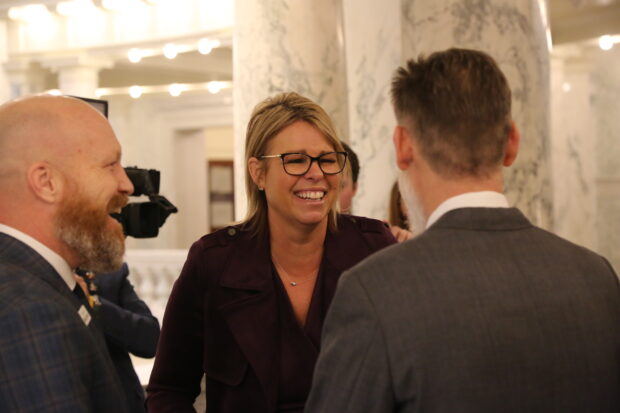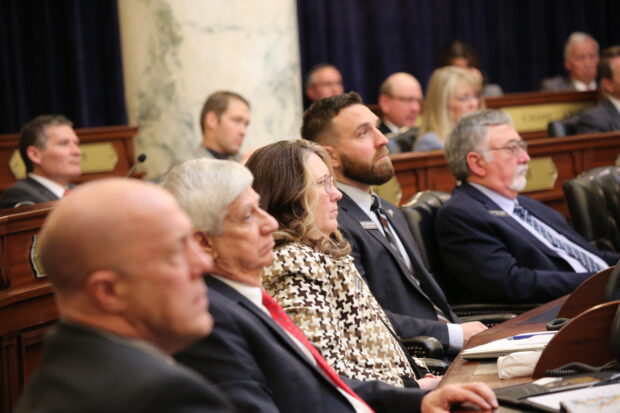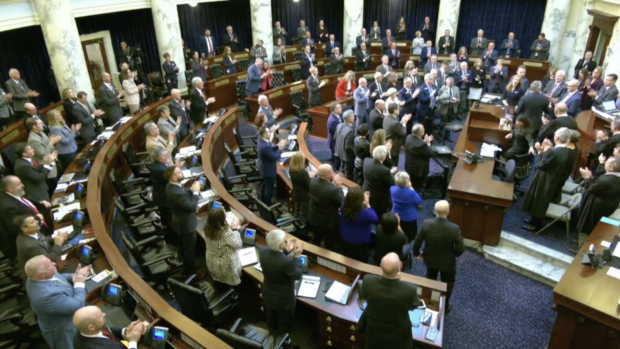Gov. Brad Little pledged to continue his commitment to Idaho education Monday during his annual State of the State address that kicked off the 2023 legislative session.
Little’s “Idaho First” agenda included proposals to boost teacher pay, increase discretionary funds for school districts and create a new scholarship fund for high school graduates. He hopes to use some of the $410 million set aside for education by the Legislature in September to achieve his goals.
“We are not backing down on education; we are doubling down on education,” Little said in his Statehouse address delivered to legislators.
Education has been a top priority for the governor since his first term began in 2019, and especially over the past year. In September, Little called a one-day legislative session to boost funding for education and approve $650 million in permanent and one-time tax cuts.
Little is now entering his second term, after getting reelected in November.

State superintendent Debbie Critchfield, who kicked off her first term in office last week, said she appreciates the governor’s dedication to education. Listing education first during his address, she said, showed where his priorities lie.
“Looking at his goals as they align to my goals and priorities…I’m very excited by it,” Critchfield said Monday, immediately following the governor’s address.
The Legislature’s budget-writing Joint Finance-Appropriations Committee will take its first look at the governor’s budget Tuesday morning. Lawmakers can choose to fund — or not fund — any of the governor’s proposals.
Little talks teacher pay, workforce development and parent choice
Little outlined a number of education proposals Monday, starting with a plan to establish an “Idaho Launch” scholarship. The fund would make available $8,500 in one-time scholarships for graduating high school students to attend an Idaho university, community college, career-technical program or another workforce training program, starting with the graduating class of 2024.
In October, the student body presidents from the College of Western Idaho, Boise State University, Lewis-Clark State College and the University of Idaho wrote an article urging the governor and Legislature to “invest directly in Idaho students” by creating a statewide scholarship fund. Little cited the article in his speech and introduced the students, who sat in the crowd at the Statehouse.
The governor also wants to make permanent the Empowering Parents grant program — a state initiative currently supported by COVID-19 relief funds. The program, originally intended to alleviate pandemic learning loss, provides grants of up to $1,000 per child or $3,000 per family, for education needs like tutoring or technology.

The grants “keep parents in the driver’s seat of their children’s education, as it should be,” Little said Monday.
The $30 million line item for the grant program is the only proposal in the governor’s budget related directly to school choice — which could be one of the biggest issues of the 2023 legislative session.
Critchfield said she supports making the grant program permanent to reinforce parental choice.
Though it started as a tool to offset learning loss, “it became a tool for parents across the board, regardless of what their needs were,” Critchfield said. “It really supported choices.”
Little also proposed an added $145 million for enhanced teacher pay, and hopes to lift Idaho into the top 10 in the nation for starting teacher pay. If passed by the Legislature, the proposals could mean a $6,300 raise for the average teacher and a starting teacher salary of $47,477.
Teacher pay, paired with growing demands in the field, is a top concern for many educators.
In a fall 2022 EdNews survey of more than 500 Idaho teachers, 52% said low pay was a “serious” or “very serious” concern, and as of October, 27 of 36 administrators surveyed by EdNews said their teacher turnover this year was “more than average.”
And although Idaho has seen an 18% boost in the average teacher salary since the career ladder was implemented in 2016-17, booming housing costs, higher pay in neighboring states, pandemic-era learning challenges and rising wages in non-teaching fields are putting pressure on districts to pay more, or face troubles recruiting and retaining educators.
Critchfield supports increasing teacher pay too, but says there’s more that needs to be done to recruit and retain good teachers.
“There are things I can do on the Department of Education end … to attract people that are passionate for education,” she said.
The governor’s budget also calls for additional funds to fill the nearly $100 million gap in state funding for classified staff wages.
School facilities, another hot topic among legislators and public school advocates, could also receive additional state funds.
Idaho is facing an $874 million backlog in school maintenance needs, according to a report released by the Office of Performance Evaluations last year. And as big school bonds continue to float and fail, some districts — like Salmon, Middleton and Idaho Falls — are hitting their limits with overcrowded schools and severe maintenance needs.
Little’s budget allocates $20 million in one-time grants for school facility security projects and maintenance across the state. Another $52.4 million could go to districts to be used at the discretion of local school leaders.
Little did not specify a use for the discretionary funds, but said they would allow districts to “meet local needs and defray reliance on property taxes.” And another $120 million, set aside in the budget for general property tax relief, could go toward alleviating the school bond and levy burden on local taxpayers.
The governor’s budget also includes line items to help preserve school information technology, improve dyslexia outcomes across the state, and boost funds available to local districts for health insurance.

Reactions to the governor’s address
Idaho Education Association president Layne McInelly, on behalf of the state teachers union members, thanked the governor for supporting education in a statement issued after the address. IEA members, he said, “enthusiastically endorse” the governor’s proposals for Idaho schools.
Boosting pay for teachers and classified staff, McInelly said, could help keep high-quality educators and support staff in schools.
“Governor Little’s proposed investment in Idaho’s public school students, classrooms and educators is an extraordinary commitment to the future of this state,” the IEA president said.
The Idaho School Boards Association, which represents over 800 school board trustees across the state, also released a statement supporting Little’s proposals — specifically the boost to classified staff pay and funding stream for school safety, which align with two of the ISBA’s 14 legislative resolutions, passed in November.
“The Idaho School Boards Association (ISBA) is thrilled to hear that the Governor is committed to supporting Idaho public education in 2023,” the release states.
Lt. Gov. Scott Bedke also applauded Little’s plan in a Monday press release.
“I am proud of what we have accomplished together for our state, and I look forward to working with the Governor and Legislature as we strive to further strengthen public schools, infrastructure, businesses, families, and our economy,” Bedke said. “Let’s roll up our sleeves and get to work.”
But the Idaho Freedom Foundation — a conservative, Boise-based think tank — wasn’t pleased with the governor’s address.
IFF president Wayne Hoffman encouraged other lawmakers to disregard Little’s speech in a statement Monday.
Hoffman said the governor ignored the “cultural and economic crisis our state and nation faces,” including alleged “wokeism and leftist propaganda” in schools, and “continued leftist indoctrination on Idaho’s college and university campuses.”
Click here to read the governor’s address in full.
